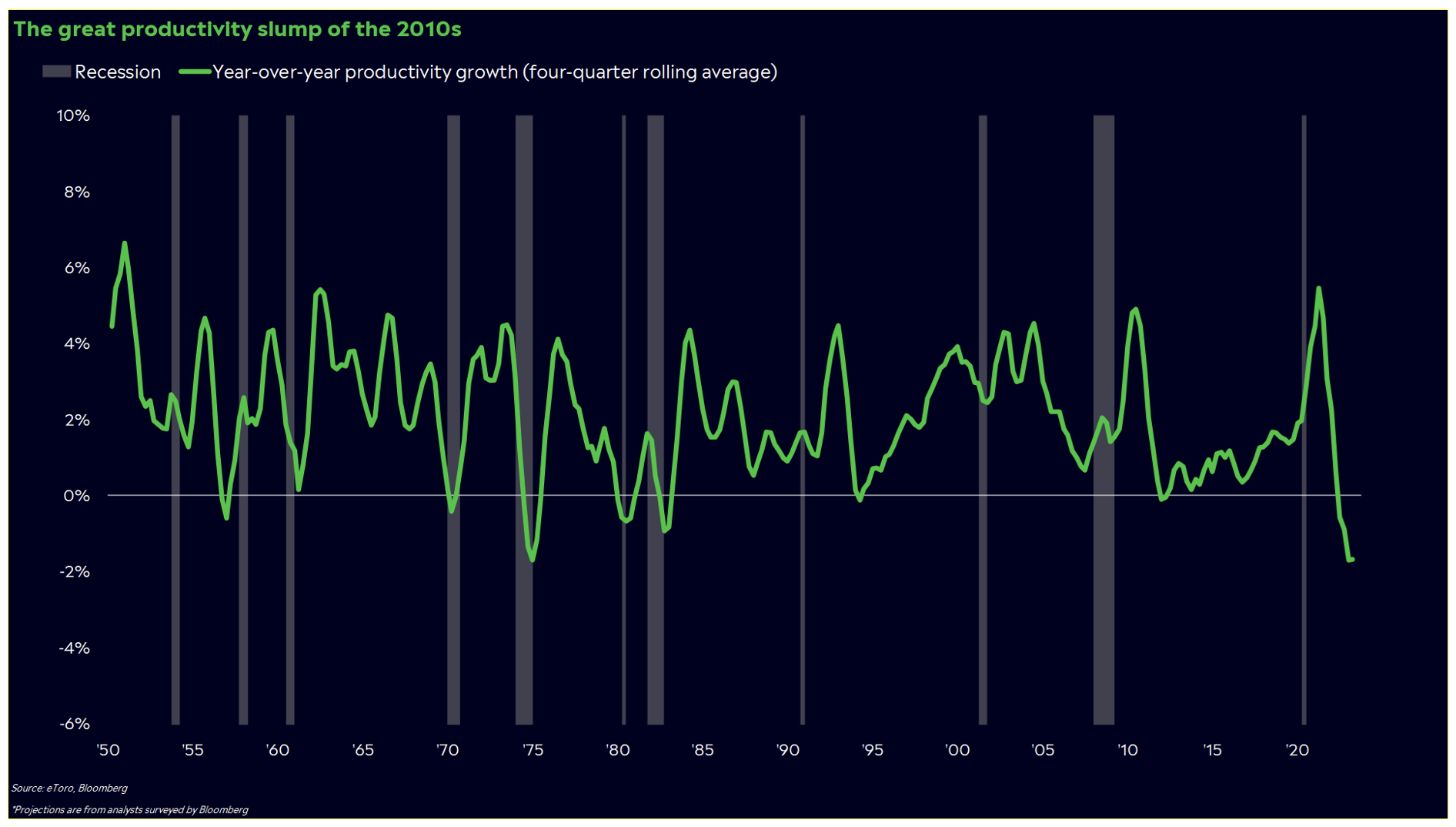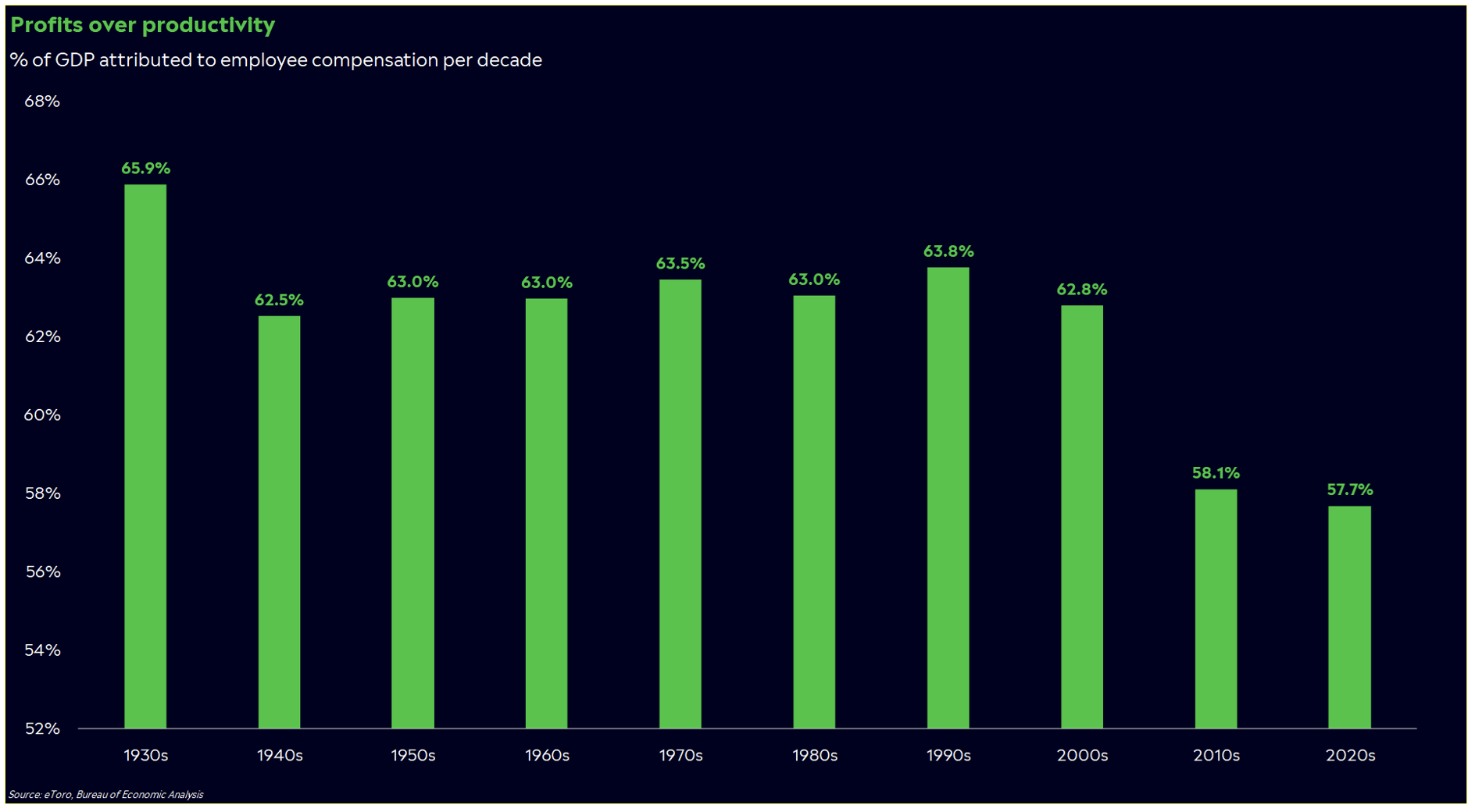By Callie Cox
AI has been called a lot of things this year. Some I’ve seen: a mind reader, a solution to rebuild the middle class, the bridge to world peace. And now, some are calling it an old-fashioned bubble in a time when tech stocks are dragging the rest of the market down.
Let me set the record straight for you. Nobody can correctly call when stocks are in a bubble, and I’m not about to do that. But I do think there’s one metric that I think could show us how much of this AI hype is real: productivity.
While AI can help us be more productive as individuals, gains in collective productivity — the amount of economic value created per hours of work — could ultimately help justify these higher stock prices.

In theory, AI could easily drive productivity in an economic sense. Getting robots to do our mundane tasks could not only make us more efficient, but it could be cheaper in the long run as we focus more on projects that require a human touch. And let’s be honest — robots can do a lot of what we do at a lower cost.
By that logic, you’d probably think productivity has boomed over the past decade. But in practice, it hasn’t been that simple.
Productivity has been unusually sluggish, even though the past decade has been defined by the rise of big tech and an explosion in innovation and development. In fact, 2022 was the worst year for productivity in decades, marred by broken supply chains, high inflation, and low output. And in the 2010s, the economy grew at the slowest pace since the 1940s.
There are a few theories as to why a tech boom didn’t do much for the economy. Maybe the best tech breakthroughs — think electricity and the internet — are behind us. Or maybe economic data doesn’t adequately measure just how much tech has improved our lives. And some tech developments — like social media — may be cutting into our productivity instead of helping it.
For me, one chart explains it all: the share of GDP growth attributed to labor versus capital. The benefits we reaped from tech have increasingly gone to maximizing corporate profits and pleasing shareholders over empowering workers and striving for long-term resiliency.

This shift from financial engineering to capital investment is crucial. If companies focus on improving their workforces, their employees get better training and tools to work with. Eventually, this could turn into wage growth accompanied by higher output, an ideal situation that could help ease societal tensions like income inequality. Higher profits are best sustained through productivity growth, and companies ultimately live and die by their profitability.
This is where AI comes in.
Productivity is how technology takes hold in a sustainable way. If AI is going to change the world, it’ll need companies to invest meaningfully in it — not just to boost profits, but to make our systems more efficient and resilient. This is the productivity boom that Wall Street is talking about — one we haven’t seen since the early days of the Internet.
The good news? Companies may be willing to spend serious money on AI if this earnings season is any indication. Over 70 S&P 500 companies mentioned AI in their earnings calls this quarter — ranging from restaurant operators to online marketplaces and dating apps. COVID-era struggles have also forced companies to think about operational resiliency, so this could be AI’s moment to shine.
Like many of you, I’m excited about AI. And unlike many people on Wall Street, I’m not ready to call it a bubble yet. AI is a young field, so there aren’t many public AI-centric companies to invest in. Because of this, we’re seeing a lot of investor money flow to a handful of stocks, including the big tech conglomerates with healthy profit margins and big cash hoards. That doesn’t feel very bubbly to me.
Be careful, though. I’m not sure AI will solve all the problems we’re claiming it will. And after the recent productivity slump, I’m inclined to wonder if there may be more hype than substance, at least from an economic standpoint.
In a broader sense, I’d like to see productivity make a comeback in this next expansion — for the sake of our economy. And I’m hoping AI can get us there.
So what does this mean for you?
Think about how AI fits in your portfolio. While you may also be excited about AI, you have to recognize that it’s a young and emerging field. And right now, high interest rates and scarce funding are making it especially tough for small, speculative companies to operate. AI is exciting, but it may be a better investment for people with longer timeframes and strong stomachs.
Watch the data. Economic data could eventually tell us if productivity is truly growing. I keep an eye on durable goods data to gauge business investment. And of course, there’s the productivity report, which comes out about a month into every quarter.
Choose your investing tools. People may be flocking to tech stocks, but there’s more than one way to invest in a theme. Think about the suppliers that could power the AI boom and the industries that could embrace AI the most. Plus, with an emerging trend, it’s hard to tell which companies could turn out to be leaders in the space.
If you want to read more research and analysis from eToro, check us out here.
The views and opinions expressed herein are the views and opinions of the author and do not necessarily reflect those of Nasdaq, Inc.

